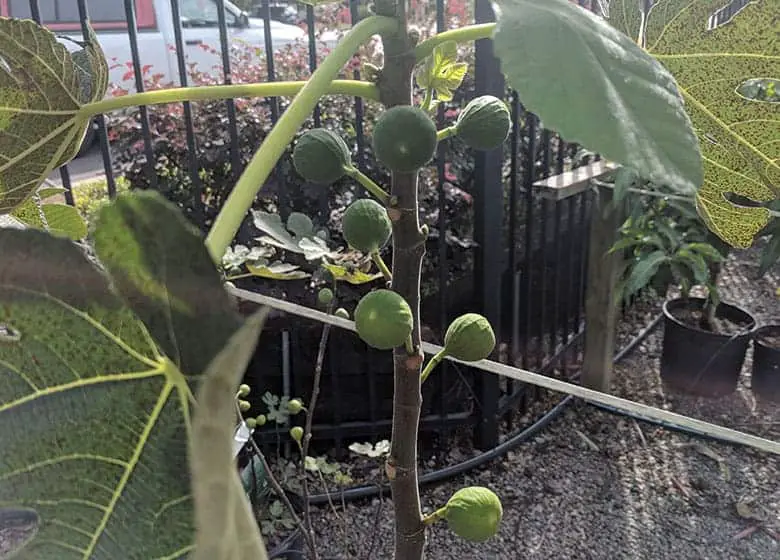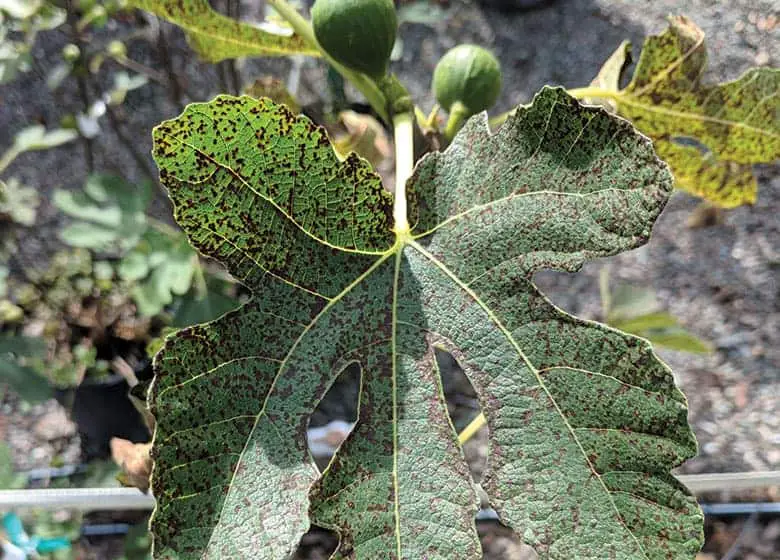Living in Florida is fantastic for growing lots of fruit trees, especially figs. You can have fresh figs, fig pie, dried figs, fig jam…the possibilities are endless.
Can you grow figs in Florida?
Fig trees thrive in Florida, especially the Celeste, Brown Turkey, Green Ischia, and Jelly varieties, which adapt well to local soil and climate. These trees enjoy full sunlight and can be grown in pots or directly in the ground. Fertilize monthly with a well-balanced fertilizer and add calcium once a year. Figs typically produce fruit twice a year after about two years of growth. Leaf rust and birds may present challenges, but they don’t significantly impact overall production
Figs can grow to about 15 feet tall and just as wide in Florida conditions. They are deciduous trees and can produce fruit twice in the same year. Fig trees are large producers and you may have to fight the birds for your first few fruits. Caring for a fig requires a few other bits of knowledge to grow a successful tree.
Best fig trees for Florida

the best fig trees are ones that have adapted to our Florida soil and climate.
- Celeste
- Brown Turkey
- Green Ischia
- Jelly
These varieties are cold hardy and adapted well to the south. They are also what’s called a common fig.
There are four different types of fig tree; common, caprifigs, Smyrna, and San Padro.
All but the common fig requires a specific kind of wasp for pollination. This wasp that is required does not live in Florida. This is why only common figs are recommended for growing in Florida
Celeste is the Florida favorite. It has small, juicy, bronzey purple fruit.
Brown Turkey is also really popular with a similar fruit except its fruit has a little hole in the bottom.(watch out for little critters in there)
Green Ischia, is a medium-sized fig. It makes a green fruit which birds seem to have a hard time spotting.
Jelly fig trees make a medium sized yellow fruit that is super sweet.
Best time to plant a fig tree in Florida
Getting your fig in the ground around March gives you the best opportunity to grow a healthy fig. Figs love the late winter/early spring weather. However, if you’re not starting with a cutting and you bought a plant from your local nursery you should have pretty good luck planting your tree at any time of the year.
How to plant a fig tree
Fig trees prefer full sun. Wherever you stick your tree make sure it gets full sun, it enjoys the Florida rays.
Figs don’t mind growing in a pot. They have a fibrous root system and don’t really dive that deep into the soil. A potted fig tree will obviously grow much smaller than a fig tree planted in the ground. Make sure you choose a pot that is big enough to support the growth of your tree. The bigger the pot, the bigger your tree.
If you are planting directly into the dirt make sure you avoid an area that collects a lot of water. Fig trees don’t like wet feet.
Dig a hole twice as big as the roots on your plant are. Going both wide and deep. water as you set the fig in place and begin to add soil. position your plant so that the root ball is about 2 inches above the normal soil line.
This will compensate for settling.
Build a little soil ring around your plant to help retain water. Leave some space between the trunk and your ring, you don’t want the water to pool right up on the tree.
I’ve also found it super beneficial to mulch. Mulching anything that you are growing is one of the most important aspects of growing healthy plants.
When do figs ripen in Florida?
figs take about two years to start producing fruit. If you’re starting from a cutting or with a really young tree, be patient.
but once figs get going they will produce food for you for years.
figs produce twice a year. The first time the produce fruit in the year is called breba. These fruits pop up early in the year and are usually grown on last years growth of the tree. The figs grown at this time of the year are generally of lower quality.
They are smaller, a little bit harder, and not as sweet. They are still edible and are a great option for making preserves or jam.
But the second production of the year is where you will get your GOOD figs.
This happens later in the year on the new growth of the plant. Harvest time is normally around the beginning of fall.
Figs will give you fruit twice a year in Florida.
When to prune a fig tree in Florida
The fig is a deciduous tree. This means that it loses its leaves every year.
This is normally during the winter time and this is also the best to prune your fig tree.
Figs don’t like heavy pruning. If you start going crazy and chop all of the branches back you will hurt the number of figs that you are going to get.
The tree needs those branches to put figs on.
Trimming the newest few inches of every branch is fine. you want to trim branches when they are about the thickness of a finger.
In fact, figs seem to prefer it. With this kind of pruning, you are teaching your fig tree to grow thicker, not taller.
This is healthy for the tree and promotes better fruit production. This style of pruning also makes it easier to pick your fruits too.
Best fertilizer for fig tree
Figs like a well-balanced fertilizer, something like an 8-8-8(Check price on Amazon) will do just fine.
But honestly you can just use your favorite fertilizer is you have one, it won’t hurt your plant. Just make sure you are following the directions on the bag as to how much to give each time.
I usually try to fertilize with this type of fertilizer once a month.
Robert bowden, Author of Florida fruit and vegetable gardening has found that Fig trees like a dose of calcium.
he suggests throwing one cup of calcium nitrate around the tree’s canopy once a year.
Fig tree problems in Florida

The biggest problem that we will see in Florida on our fig trees is leaf rust. You can choose to treat it with sprays if you want. But I wouldn’t even worry about it really.
Figs trees lose their leaves every year.
Why even waste the time treating something when those leaves are going to fall off anyways. I’m all about maximizing my return for the least investment.
In other words, I’m lazy and I don’t see a point in fighting this problem.
Fig trees do have a very common “pest”. It’s not bugs like in vegetable gardening but it’s the birds.
Birds will take your figs.
You can try to cover your tree with netting.
But again, I think that sounds like a lot of work. My answer would be to have more than one fig tree.
After a few years, you will be producing more fruit than you know what to do with. This way, it’s ok if a few birds take a couple figs.
Birds in the garden are super beneficial, so it’s actually a win for you.
Growing Fig Trees In Florida
- Choose Florida friendly varieties like Celeste, Brown Turkey, Green Ischia, Jelly.
- North and central Florida will have no problem growing figs, Southern Floridians will have a harder time producing fruit.
- figs love full sun
- Figs Can be grown in containers or planted into the ground. If planted into the ground dig a hole twice as deep and wide as the root ball.
- Be sure to mulch around your fig tree
- figs don’t like heavy pruning, trim lightly when they lose their leaves in the winter.
- A well-balanced fertilizer and a little bit of calcium will have your tree looking happy.
- Fig trees may be attacked by leaf rust and birds will probably want to share your fruit with you.
